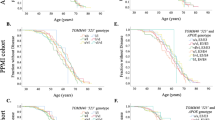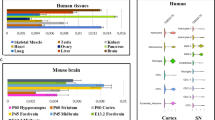Abstract
The activity of complex I of the mitochondrial respiratory chain has been found to be decreased in patients with Parkinson’s disease (PD), but no mutations have been identified in genes encoding complex I subunits. Recent studies have suggested that polymorphisms in mitochondrial DNA (mtDNA)-encoded complex I genes (MTND) modify susceptibility to PD. We hypothesize that the risk of PD is conveyed by the total number of nonsynonymous substitutions in the MTND genes in various mtDNA lineages rather than by single mutations. To test this possibility, we determined the number of nonsynonymous substitutions of the seven MTND genes from 183 Finns. The differences in the total number of nonsynonymous substitutions and the nonsynonymous to synonymous substitution rate ratio (K a /K s ) of MTND genes between the European mtDNA haplogroup clusters (HV, JT, KU, IWX) were analysed by using a statistical approach. Patients with PD (n=238) underwent clinical examination together with mtDNA haplogroup analysis and the clinical features between patient groups defined by the number of nonsynonymous substitutions were compared. Our analysis revealed that the haplogroup clusters HV and KU had a lower average number of amino acid replacements and a lower K a /K s ratio in the MTND genes than clusters JT and IWX. Supercluster JTIWX with the highest number of amino acid replacements was more frequent among PD patients and even more frequent among patients with PD who developed dementia. Our results suggest that a relative excess of nonsynonymous mutations in MTND genes in supercluster JTWIX is associated with an increased risk of PD and the disease progression to dementia.

Similar content being viewed by others
References
Betarbet R, Sherer TB, MacKenzie G, Garcia-Osuna M, Panov AV, Greenamyre JT (2000) Chronic systemic pesticide exposure reproduces features of Parkinson’s disease. Nat Neurosci 3:1301–1306
Chinnery PF, Johnson MA, Wardell TM, Singh-Kler R, Hayes C, Brown DT, Taylor RW, Bindoff LA, Turnbull DM (2000) The epidemiology of pathogenic mitochondrial DNA mutations. Ann Neurol 48:188–193
Daniel SE, Lees AJ (1993) Parkinson’s disease society brain bank, London: overview and research. J Neural Transm 39(Suppl):165–172
Finnilä S, Lehtonen MS, Majamaa K (2001) Phylogenetic network for European mtDNA. Am J Hum Genet 68:1475–1484
Fu YX (1997) Statistical tests of neutrality of mutations against population growth, hitchhiking and background selection. Genetics 147:915–925
Fu YX, Li WH (1993) Statistical tests of neutrality of mutations. Genetics 133:693–709
Gerber AS, Loggins R, Kumar S, Dowling TE (2001) Does nonneutral evolution shape observed patterns of DNA variation in animal mitochondrial genomes? Annu Rev Genet 35:539–566
Gu M, Cooper JM, Taanman JW, Schapira AHV (1998) Mitochondrial DNA transmission of the mitochondrial defect in Parkinson’s disease. Ann Neurol 44:177–186
Harding AJ, Halliday GM (2001) Cortical Lewy body pathology in the diagnosis of dementia. Acta Neuropathol 102:355–363
Ihaka R, Gentleman R (1996) R: a language for data analysis and graphics. J Comp Graph Stat 5:299–314
Ingman M, Kaessmann H, Pääbo S, Gyllensten U (2000) Mitochondrial genome variation and the origin of modern humans. Nature 408:708–713
Kösel S, Grasbon-Frodl EM, Hagenah JM, Graeber MB, Vieregge P (2000) Parkinson disease: analysis of mitochondrial DNA in monozygotic twins. Neurogenetics 2:227–230
Lehtonen MS, Moilanen JS, Majamaa K (2003) Increased variation in mtDNA in patients with familial sensorineural hearing impairment. Hum Genet 113:220–227
Mathiesen C, Hägerhäll C (2002) Transmembrane topology of the NuoL, M and N subunits of NADH:quinone oxidoreductase and their homologues among membrane-bound hydrogenases and bona fide antiporters. Biochim Biophys Acta 1556:121–132
Moilanen JS, Majamaa K (2003) Phylogenetic network and physicochemical properties of nonsynonymous mutations in the protein-coding genes of human mitochondrial DNA. Mol Biol Evol 20:1195–1210
Nicklas WJ, Heikkilä RE (1985) Inhibition of NADH-linked oxidation in brain mitochondria by 1-methyl-4-phenylpyridine, a metabolite of the neurotoxin, 1-methyl-4-phenyl-1,2,3,6-tetrahydropyridine. Life Sci 36:2503–2508
Nielsen R (2001) Statistical tests of selective neutrality in the age of genomics. Heredity 86:641–674
Parker WD, Boyson SJ, Parks JK (1989) Abnormalities of the electron transport chain in idiopathic Parkinson’s disease. Ann Neurol 26:719–723
Poulton J, Luan J, Macaulay V, Hennings S, Mitchell J, Wareham NJ (2002) Type 2 diabetes is associated with a common mitochondrial variant: evidence from a population-based case-control study. Hum Mol Genet 11:1581–1583
Ross OA, McCormack R, Maxwell LD, Duguid RA, Quinn DJ, Barnett YA, Rea IM, El-Agnaf OMA, Gibson JM, Wallace A, Middleton D, Curran MD (2003) mt4216C variant in linkage with the mtDNA TJ cluster may confer a susceptibility to mitochondrial dysfunction resulting in an increased risk of Parkinson’s disease in Irish. Exp Gerontol 38:397–405
Ruiz-Pesini E, Lapeña A-C, Díez-Sánchez C, Pérez-Martos A, Montoya J, Alvarez E, Díaz M, Urriés A, Montoro L, López-Pérez MJ, Enríquez JA (2000) Human mtDNA haplogroups associated with high or reduced spermatozoa motility. Am J Hum Genet 67:682–696
Schapira AHV, Cooper JM, Dexter D, Clark JB, Jenner P, Marsden CD (1990) Mitochondrial complex I deficiency in Parkinson’s disease. J Neurochem 54:823–827
Shoffner JM, Watts RL, Juncos JL, Torroni A, Wallace DC (1991) Mitochondrial oxidative-phosphorylation defects in Parkinson’s disease. Ann Neurol 30:332–339
Shoffner JM, Brown MD, Torroni A, Lott MT, Cabell MF, Mirra SS, Beal MF, Yang CC, Gearing M, Salvo R, Watts RL, Juncos JL, Hansen LA, Crain BJ, Fayad M, Reckord CL, Wallace DC (1993) Mitochondrial DNA variants observed in Alzheimer disease and Parkinson disease patients. Genomics 17:171–184
Simon DK, Pulst SM, Sutton JP, Browne SE, Beal MF, Johns DR (1999) Familial multisystem degeneration with parkinsonism associated with the 11778 mitochondrial DNA mutation. Neurology 53:1787–1793
Simon DK, Mayeux R, Marder K, Kowall NW, Beal MF, Johns DR (2000) Mitochondrial DNA mutations in complex I and tRNA genes in Parkinson’s disease. Neurology 54:703–709
Simonsen KL, Churchill GA, Aquadro CF (1995) Properties of statistical tests of neutrality for DNA polymorphism data. Genetics 141:413–429
Smeitink J, Heuvel L van den (1999) Protein biosynthesis ‘99. Human mitochondrial complex I in health and disease. Am J Hum Genet 4:1505–1510
Sutton JP, Pulst SM (1997) Atypical parkinsonism in a family of Portuguese ancestry: absence of CAG repeat expansion in the MJD1 gene. Neurology 48:1285–1290
Swerdlow RH, Parks JK, Miller SW, Tuttle JB, Trimmer PA, Sheehan JP, Bennett JP, Davis RE, Parker WD (1996) Origin and functional consequences of the complex I defect in Parkinson’s disease. Ann Neurol 40:663–671
Swerdlow RH, Parks JK, Davis JN II, Cassarino DS, Trimmer PA, Currie LJ, Dougherty J, Bridges WS, Bennett JP, Wooten GF, Parker WD (1998) Matrilineal inheritance of complex I dysfunction in a multigenerational Parkinson’s disease family. Ann Neurol 44:873–881
Tajima F (1989) Statistical method for testing the neutral mutation hypothesis by DNA polymorphism. Genetics 123:585–595
Tanaka M, Gong JS, Zhang J, Yoneda M, Yagi K (1998) Mitochondrial genotype associated with longevity. Lancet 351:185–186
Tatton WG, Chalmers-Redman R, Brown D, Tatton N (2003) Apoptosis in Parkinson’s disease: signals for neuronal degradation. Ann Neurol 53(Suppl 3):S61–S70
Torroni A, Huoponen K, Francalacci P, Petrozzi M, Morelli L, Scozzari R, Obinu D, Savontaus ML, Wallace DC (1996) Classification of European mtDNAs from an analysis of three European populations. Genetics 144:1835–1850
Vives-Bauza C, Andreu AL, Manfredi G, Beal MF, Janetzky B, Gruenewald TH, Lin MT (2002) Sequence analysis of the entire mitochondrial genome in Parkinson’s disease. Biochem Biophys Res Commun 290:1593–1601
Wallace DC (1995) 1994 William Allan Award Address. Mitochondrial DNA variation in human evolution, degenerative disease, and aging. Am J Hum Genet 57:201–223
Wallace DC, Brown MD, Lott MT (1999) Mitochondrial DNA variation in human evolution and disease. Gene 238:211–230
Walt JM van der, Nicodemus KK, Martin ER, Scott WK, Nance MA, Watts RL, Hubble JP, Haines JL, Koller WC, Lyons K, Pahwa R, Stern MB, Colcher A, Hiner BC, Jankovic J, Ondo WG, Allen Jr. FH, Goetz CG, Small GW, Mastaglia F, Stajich JM, McLaurin AC, Middleton LT, Scott BL, Schmechel DE, Pericak-Vance MA, Vance JM (2003) Mitochondrial polymorphisms significantly reduce the risk of Parkinson disease. Am J Hum Genet 72:804–811
Watterson GA (1975) On the number of segregating sites in genetical models without recombination. Theor Popul Biol 7:256–276
Yang Z (1997) PAML: a program package for phylogenetic analysis by maximum likelihood. CABIOS 13:555–556
Yang Z, Nielsen R (2000) Estimating synonymous and nonsynonymous substitution rates under realistic evolutionary models. Mol Biol Evol 17:32–43
Acknowledgements
The authors thank Ms. Irma Vuoti for her expert technical assistance. This study was supported by grants from the Medical Research Council of the Academy of Finland, the Sigrid Juselius Foundation and the Finnish Parkinson Association.
Author information
Authors and Affiliations
Corresponding author
Rights and permissions
About this article
Cite this article
Autere, J., Moilanen, J.S., Finnilä, S. et al. Mitochondrial DNA polymorphisms as risk factors for Parkinson’s disease and Parkinson’s disease dementia. Hum Genet 115, 29–35 (2004). https://doi.org/10.1007/s00439-004-1123-9
Received:
Accepted:
Published:
Issue Date:
DOI: https://doi.org/10.1007/s00439-004-1123-9




